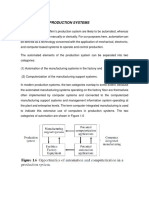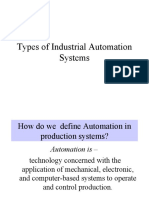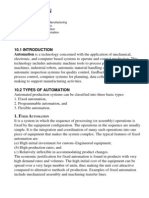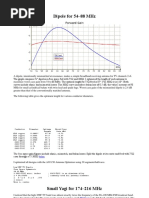0 ratings0% found this document useful (0 votes)
10 viewsUnit Vi Automation and Robotics
Uploaded by
omkarbangare07Copyright
© © All Rights Reserved
Available Formats
Download as PDF, TXT or read online on Scribd
0 ratings0% found this document useful (0 votes)
10 viewsUnit Vi Automation and Robotics
Uploaded by
omkarbangare07Copyright
© © All Rights Reserved
Available Formats
Download as PDF, TXT or read online on Scribd
You are on page 1/ 40
UNIT – VI Automation and Robotics
Course Outcome- Maintain the functioning of automated equipment
Curriculum
• Automation – Define, need of automation, high and low cost
automation, examples of automation.
• Types of automation – Fixed(Hard) automation, programmable
automations and flexible automations(soft). Comparison of types of
automations.
• Group Technology- concept, basis for developing part families, part
classification and coding with examples, concept of cellular
manufacturing. Advantages and limitations.
• Flexible manufacturing system- Introduction, concept, definition
and need, sub system of FMS, comparing with other manufacturing
approaches.
• Introduction to Robotics – definition of robot and robotics,
advantages disadvantages and applications.
• Components of Robotics manipulator, end effectors, actuators,
sensors, controller, processor and software.
Automation
• Definition -Automation can be defined as a
technology concerned with the application of
mechanical, electronic and computer based systems
to operate and control the production.
• The term automation means a higher degree of
mechanization
• It represents a process in which all the operations
like material handling, material processing and
inspection are performed automatically.
• It means that operator is required only for
supervision and can operate number of machines at
one time.
• It is implemented by using a program of instructions
combined with a control system that executes the
program.
• E.g. Assembly line of an automobile
An automated sugar factory
Printing of newspaper
Need of Automation
Increase labour productivity
Reduce labour cost
Mitigate the effects of labour shortage
Reduce or eliminate routine manual and
clerical tasks
Improve worker safety
Improve product quality
Reduce manufacturing lead time
Accomplish processes that cannot be done
manually
Examples of Automation
Self driven trucks that makes long distance deliveries
without a driver
Self driving vehicles where the vehicle itself is a driver
which can take you safe at the desired location
Machine automation in packaging of products,
pharmaceutical industry, milk bottling plant, assembly of
various components etc.
Use of robots in transfer of materials in hospitals, cleaning
of passages.
Robotic arms for assembly of parts, pick and drop
Home appliances like fully automatic washing machine,
toaster, coffee makers.
Online payment systems through use of applications like
Phone pay, BHIM, Google pay.
Full automation in sugar factory, newspaper printing, pencil
manufacturing etc.
Types of Automation
Fixed automation
Programmable automation
Flexible automation
Integrated automation
Fixed Automation
Fixed automation also referred to as hard
automation, is the use of special purpose
equipment to automate the assembly line.
The machine are arranged as per the sequence of
operations to be performed.
It is inflexible and cannot accommodate the
variety of product
The product design is constant for a long period
of time
The parts are produced on a large scale
The production rates are very high
E.g. Transfer lines, automated assembly lines etc.
Fixed Automation
Advantages
1. Low unit cost
2. Automated material handling
3. Relatively inflexible in accommodating
product changes
Disadvantages
1. High initial investment
2. Relatively inflexible in accommodating
product changes
3. Modifying hard automation can be costly and
time-consuming
Programmable Automation
Programmable automation also referred to as soft
automation, includes equipment that has been designed to
accommodate a variety of product configuration
In programmable automation, the production equipment is
designed with the capability to change the sequence of
operations to accommodate different product configuration
The sequence of operation depends on program written
A new program has to be written for a new product
Flexible to deal with variations and changes in product
configuration
It is used for low volume production where parts are
produced in batches
E.g. NC machine tool, PLC, Industrial robots etc.
Programmable Automation
Advantages
1. Flexible to deal with design variations
2. Suitable for batch production
Disadvantages
1. High initial investment in general purpose
equipment
2. Lower production rate than fixed automation
3. New program is to be written for every new
batch
Flexible Automation
A flexible automation system is capable of
producing a variety of parts with virtually no time
lost for changeovers from one part style to the
next.
Flexible automation is an extension of
programmable automation
Features of flexible automation
1. High investment for a custom-engineered
system.
2. Continuous production of variable mixture of
products
3. Medium production rates
4. Flexible to deal with product design variations
Flexible Automation
Advantages
1. Continuous production of variable mixture of
product
2. Flexible to deal with product design variation
Disadvantages
1. High production rate
2. High investment
3. High unit cost relative to fixed automation
Integrated Automation
Manufacturing functions are linked through an
integrated computer network.
These manufacturing functions include
production planning and control, shop floor
control, quality control, purchasing, marketing
etc.
Allow changes in product design to reduce
costs and to optimize production
requirements.
E.g. computer integrated manufacturing
Integrated Automation
Manufacturing functions are linked through an
integrated computer network.
These manufacturing functions include
production planning and control, shop floor
control, quality control, purchasing, marketing
etc.
Allow changes in product design to reduce
costs and to optimize production
requirements.
E.g. computer integrated manufacturing
Group Technology
• It is defined as layout in which similar parts are
grouped together in a family in order to take the
advantage of their similarities in design and
production.
• Group technology is based on a general principle
that many problems are similar and by grouping
similar problems, a single solution can be found
to a set of problems, thus saving time and effort
Group Technology
• The machines and equipments required to manufacture the parts in
the family are organized into cell.
• Such a layout is called as Group Technology or cellular layout.
• It is not necessary for each part of a part family to be processed by
every machine of corresponding machine cell. This type of
manufacturing in which a part family is produced by a machine cell
is known as cellular manufacturing.
• The advantage of GT can be divided into three groups:
• Engineering .
• Manufacturing
• Process Planning
• GT promotes standardization of tooling, fixturing, and setups.
• Material handling is reduced because parts are moved within a
machine cell rather than within the entire factory.
• Process planning and production scheduling are simplified.
• Setup times are reduced, resulting in lower manufacturing lead
times.
PART CLASSIFICATION AND CODING
• Classification is the process of dividing set of
parts into families
• Coding is the process of allocating symbols to
the parts.
• It involves classifying the parts into families by
examining the individual design and
manufacturing attributes of each part.
• This classification results in a code number
that uniquely identifies the part’s attributes
• This is the most complicated and time
consuming method.
FEATURES OF PART CLASSIFICATION AND CODING
• The part classification system is based on one of the three
categories:-
A) System based on design attributes
B) System based on manufacturing attributes
C) System based on both of the above
Design attributes consists of basic (external/internal) shape,
Axisymmetric/prismatic/sheet metal, length/diameter ratio, material,
major dimensions, minor dimensions, tolerances, surface finish etc.
Manufacturing attributes consists of major process of manufacture,
surface treatments/coatings, machine tool/processing equipment,
cutting tools, operation sequence, production time, batch quantity,
production rate, fixture needed.
The part coding system consists of sequence of symbols that identify
parts design and manufacturing attributes.
The symbols are usually alphanumeric, although most systems use
only numbers.
Cellular Manufacturing
• Cellular manufacturing is an application of
group technology in manufacturing, in which
all or a portion of a firm’s manufacturing
system has been converted into cells.
• A manufacturing cell is a cluster of machines
or processes located in close proximity and
dedicated to the manufacture of a family of
parts.
• The parts are similar in their processing
requirements, such as operations, tolerances
and machine tool capacities
Objectives of Cellular Manufacturing
• The primary objectives in implementing a
cellular manufacturing system are to reduce:
• Setup times (by using part family tooling and
sequencing).
• Flow times (by reducing setup and move times
and wait time for moves and using smaller
batch sizes).
• Reduce inventories.
• Market response times
Examples of Cellular Manufacturing
Flexible Manufacturing System
• A flexible manufacturing system is an automated machine cell, consisting
of a group of processing workstations, interconnected with automated
material handling and storage system.
• The FMS is most suited for the mid-variety, mid-volume production range.
• A flexible manufacturing system (FMS) is a manufacturing system in which
there is some amount of flexibility that allows the system to react in case
of changes, whether predicted or unpredicted.
• This flexibility is generally considered to fall into two categories, which
both contain numerous subcategories.
• The first category, routing flexibility, covers the system's ability to be
changed to produce new product types, and ability to change the order of
operations executed on a part.
• The second category is called machine flexibility, which consists of the
ability to use multiple machines to perform the same operation on a part,
as well as the system's ability to absorb large-scale changes, such as in
volume, capacity, or capability.
• The work machines which are often automated CNC machines are
connected by a material handling system to optimize parts flow and the
central control computer which controls material movements and
machine flow
Flexible Manufacturing System
• Need of FMS:-
• External changes such as change in product
design and production system.
• Optimizing the manufacturing cycle time.
• Reduced production costs.
• Overcoming internal changes like breakdowns
etc.
Definition of robot and robotics
• A robot is a reprogrammable multifunctional
manipulator designed to move material, parts,
tools or specialized devices through variable
programmed motions for the performance of
a variety of tasks.
• Robot may be defined as ‘ a system that
contains sensors, control systems,
manipulators, power supplies and software all
working together to perform a task.
• Robotics is a branch of engineering that
involves the conception, design, manufacture
and operation of robots.
Definition of robot
Advantages of Robot
• Robots always do their work faster and with
consistency and perfection.
• The robot can work in dangerous
environments where it is difficult for humans
to work thereby minimizing the risk to the
human health.
• The robots do not require to sleep or take
breaks and can function without stopping thus
improving productivity.
Disadvantages of Robot
• Robots can take the place of humans, so
people have to find new jobs. If the robots
begin to replace the humans in every field it
will lead to unemployment.
• Robots need power supply to operate. It also
needs maintenance to keep them running.
The software and hardware need to be
updated to meet the requirement.
• It costs a lot of money or buy the robots, In
case of breakdown, the cost of repair may be
very high.
Applications of Robot
• In manufacturing industry for assembly of
parts
• To assist a surgeon in medical surgery.
• In military applications
• In painting of automobiles
Applications of Robot
Degree of freedom
• Degrees of freedom (DOF) “ a term that
describes a robot’s freedom of motion in three
dimensional space”
• Degree of freedom for a robot is defined as “
the number of independent movements
performed by the robot wrist in three
dimensional space, relative to the robot’s
base.
• It refers to the ability of the robot arm to move
forward and backward, up and down and to
the left
Degree of freedom
Degree of freedom
Degree of freedom
Degree of freedom
Components of Robot
• Any industrial robot has to have the following
basic parts to perform given work/job
satisfactorily :
Arm
End-effectors
Actuators
Sensors
Controllers
Drive
software
Components of Robot
ARM
The arm is the part of the robot that positions the
end-effector and sensors to do their pre-
programmed task.
Most of the robot arms resemble human arms
and have shoulders, elbows, wrist, even fingers.
A simple robot arm with three degrees of
freedom could move in any of the three
directions, up and down, left and right, forward
and backward, rotation about base etc.
Industrial robot arms can vary in size and shape.
Components of Robot
End-effectors
A hand of a robot is considered as end
effectors. The end effectors are the parts of
the robot that actually do the work.
The grippers and tools are the two significant
types of end effectors that helps the robot to
do its job.
The grippers are used to pick and place an
object, while the tools are used to carry out
operations like spray painting, spot welding
etc. on a work piece.
Components of Robot
Actuators
An actuator is a device that produces translatory or
rotary movement in the links or make the freedoms
possible.
The actuators are actuated in reaction to the feedback
from the sensors.
The most important and popular actuator is a motor
(D.C. motors, stepper motors, servo motors etc.) which
allows the robot to control a wheel, switch or even an
arm.
Stepper motor controls by increasing or decreasing the
voltage
Servo motor control by slowing or speeding up the
motor using a feedback loop.
The source of movement (drive) can be electric drive
(motor), hydraulic drive, pneumatic drive etc.
Components of Robot
Sensors
A sensor is an element in a control system that acquires a physical
parameter and changes it into signal.
The sensor sends information, in the form of electronic signals back
to the controller.
Sensors also give the robot controller information about its
surroundings and let it know the exact position of the arm, or the
state of the world around it.
Sensors can also assist end effectors by adjusting for part variances.
To know the position of each joint in the mechanical linkage,
potentiometers or encoders are used as sensors.
Tachometers or accelerometers are used to measure the velocity
and/or acceleration at each joint.
Vision sensors (cameras, laser rang finders), acoustic sensors
(ultrasonic ranging system), touch sensors are used to detect
objects or features in the environment.
Microphone allows robots to detect sounds. Sensors such as
buttons embedded in bumpers can allow the robot to determine
when it has collided with an object or a wall.
Components of Robot
Controllers
Every robot is connected to a computer that co-
ordinates both the arm to work together. This
computer is known as the controller
The controller functions as the “brain” of the robot.
The controller also allows the robot to be networked to
other systems, so that it may work together with other
machines, processes or robots.
The robotic arm controller runs a set of instructions
written in code call3ed a program.
The controller actually is some electronic device which
receives the signals from the sensors and provides it to
the drive to actuate the actuators.
The actuation produced is fed back to the controller by
the feedback element, which is compared with the
given input and further action is taken.
Components of Robot
Drive
The drive is the engine or motor that moves the
links into their designated positions. The links are
the sections between the joints.
Industrial robot arms generally use one of the
following types of drives : mechanical, hydraulic,
electric or pneumatic.
Hydraulic drive systems give a robot great speed
and strength
An electric system provides a robot with less
speed and strength
Pneumatic drive systems are used for smaller
robots that have fewer axes of movement.
You might also like
- The Mechanicals Play Within A Play Edited Script100% (1)The Mechanicals Play Within A Play Edited Script2 pages
- Automation: Levels of Automation and Its Different TypesNo ratings yetAutomation: Levels of Automation and Its Different Types10 pages
- 13-93 Unit 1 - Automation in ManufacturingNo ratings yet13-93 Unit 1 - Automation in Manufacturing81 pages
- AUTOMATION IN PRODUCTION SYSTEMS Unit 1No ratings yetAUTOMATION IN PRODUCTION SYSTEMS Unit 112 pages
- L1 - 2 - Types of Industrial Automation Systems100% (2)L1 - 2 - Types of Industrial Automation Systems31 pages
- Chapter 1 Introduction To Automation Technology0% (1)Chapter 1 Introduction To Automation Technology33 pages
- Unit-1:: Introduction To Basics of Industrial Automation100% (1)Unit-1:: Introduction To Basics of Industrial Automation23 pages
- Automation: Fixed Automation. Fixed Automation Is A System in Which The Sequence of ProcessingNo ratings yetAutomation: Fixed Automation. Fixed Automation Is A System in Which The Sequence of Processing7 pages
- AUTOMATION For Learnig Session in SEMINARSNo ratings yetAUTOMATION For Learnig Session in SEMINARS8 pages
- Topics To Be Discussed: Automation Strategies Automated Flow Lines Automated Systems Toyota Production System RoboticsNo ratings yetTopics To Be Discussed: Automation Strategies Automated Flow Lines Automated Systems Toyota Production System Robotics21 pages
- What Production Facilities Are Required?No ratings yetWhat Production Facilities Are Required?10 pages
- Basic Definition of Manufacturing SystemNo ratings yetBasic Definition of Manufacturing System18 pages
- Introduction to Industrial Automation: A Beginner’s Guide: Industrial Automation, #1From EverandIntroduction to Industrial Automation: A Beginner’s Guide: Industrial Automation, #1No ratings yet
- Introductory Chapter: New Challenges and Innovations in Grape and Wine ProductionNo ratings yetIntroductory Chapter: New Challenges and Innovations in Grape and Wine Production8 pages
- Commonlit They-Re-Made-Out-Of-Meat StudentNo ratings yetCommonlit They-Re-Made-Out-Of-Meat Student7 pages
- Arch - Part01 - Lot 1-2 - 31 Herrick ST, MT Gravatt - Rev A2 - BR20230304No ratings yetArch - Part01 - Lot 1-2 - 31 Herrick ST, MT Gravatt - Rev A2 - BR202303048 pages
- Systemized Orthodontic Treatment Mechanics100% (1)Systemized Orthodontic Treatment Mechanics312 pages
- 34 WaterScienceandTechnology2013 duPisaniMengeNo ratings yet34 WaterScienceandTechnology2013 duPisaniMenge15 pages
- Grade 8 Study List Term 3 Final Exam ZehranNo ratings yetGrade 8 Study List Term 3 Final Exam Zehran11 pages
- Mada Wall Stud (C-STUD) : Product Description Product CharacteristicsNo ratings yetMada Wall Stud (C-STUD) : Product Description Product Characteristics1 page
- Customer Satisfaction Towards Cooking Oil - FinalNo ratings yetCustomer Satisfaction Towards Cooking Oil - Final17 pages
- Area and Volume Formula For Geometrical FiguresNo ratings yetArea and Volume Formula For Geometrical Figures1 page
- MOEP - Public-Private Partnership Development in Thermal Power Generation, Thermal Power Department, Myanmar Electric Power EnterpriseNo ratings yetMOEP - Public-Private Partnership Development in Thermal Power Generation, Thermal Power Department, Myanmar Electric Power Enterprise15 pages
- CLT South Africa Xlam Brochure-Version-2.0No ratings yetCLT South Africa Xlam Brochure-Version-2.010 pages
- Automation: Levels of Automation and Its Different TypesAutomation: Levels of Automation and Its Different Types
- Unit-1:: Introduction To Basics of Industrial AutomationUnit-1:: Introduction To Basics of Industrial Automation
- Automation: Fixed Automation. Fixed Automation Is A System in Which The Sequence of ProcessingAutomation: Fixed Automation. Fixed Automation Is A System in Which The Sequence of Processing
- Topics To Be Discussed: Automation Strategies Automated Flow Lines Automated Systems Toyota Production System RoboticsTopics To Be Discussed: Automation Strategies Automated Flow Lines Automated Systems Toyota Production System Robotics
- Introduction to Industrial Automation: A Beginner’s Guide: Industrial Automation, #1From EverandIntroduction to Industrial Automation: A Beginner’s Guide: Industrial Automation, #1
- Introductory Chapter: New Challenges and Innovations in Grape and Wine ProductionIntroductory Chapter: New Challenges and Innovations in Grape and Wine Production
- Arch - Part01 - Lot 1-2 - 31 Herrick ST, MT Gravatt - Rev A2 - BR20230304Arch - Part01 - Lot 1-2 - 31 Herrick ST, MT Gravatt - Rev A2 - BR20230304
- Mada Wall Stud (C-STUD) : Product Description Product CharacteristicsMada Wall Stud (C-STUD) : Product Description Product Characteristics
- MOEP - Public-Private Partnership Development in Thermal Power Generation, Thermal Power Department, Myanmar Electric Power EnterpriseMOEP - Public-Private Partnership Development in Thermal Power Generation, Thermal Power Department, Myanmar Electric Power Enterprise

























































































